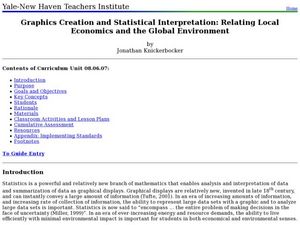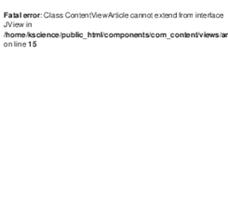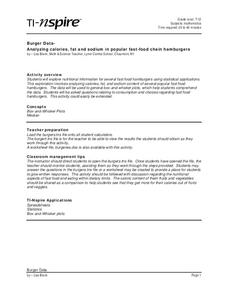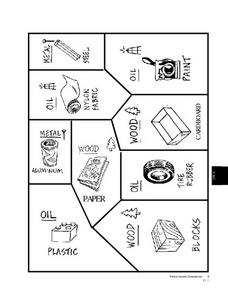Beyond Benign
Leave Only Footprints
You don't need to tip-toe around an enlightening resource. Young environmentalists learn about ecological footprints in the fourth lesson of 15. Answering a questionnaire helps them see how their own families and homes affect the...
British Council
Buy. Use. Toss.
Responsible consumption is never a waste of time. Using the engaging resource, scholars learn about the impact of waste on the planet, sorting trash into necessary and luxury piles. They then analyze their consumption habits, writing an...
College Board
2016 AP® Microeconomics Free-Response Questions
How can a bakery—one of several in town—maximize its profits? A case study from College Board asks scholars to consider the question. Other practice queries examine the price and benefits of buying certain goods for one consumer and look...
WE Charity
High School–Module 2: Circular Economy and Nature
Everyone's heard the popular slogan reduce, reuse, recycle, but there may be a better way to talk about sustainability. Using the second instructional activity from the five-part WE Are Innovators—High School Modules series, learners...
WE Charity
Elementary–Module 2: Circular Economy and Nature
How can people do their part to help protect the environment? Learners participate in an engaging jigsaw activity to discuss the causes and effects of pollution. Next, pupils develop their own innovative ideas to address an environmental...
Curated OER
Building the Aggregate Expenditures Model
A good accompaniment to an economics lesson, this presentation explores the aggregate expenditures model, detailing the relationship between consumption and saving using graphs and charts. Additional information includes investments and...
Federal Reserve Bank
Wants on a Continuum
You can't always get what you want, but you might just be able to teach your class about wants and choices. This plan leads pupils through a discussion and closes with a worksheet and assessment.
Curated OER
Watershed Ways
Students connect the water cycle concept with local fresh water availability and consumption. They identify waterways in their own region. Students define, predict, research, and map local watershed areas. They research the positive...
Curated OER
Make a Choice
Students investigate the Underground Railroad to determine the choices that people made. To help, to stay, to do nothing, to break the law to enforce the law, to feed runaways are some of the choices that made a difference. This...
Curated OER
Marketing to Teens: Gotta Have It! Designer & Brand Names
Advertisers want us to believe we would be accepted if we wore the right clothes or owned the right stuff. This assumption forms the heart of an exploration of the impact of advertising on teenagers. A safe classroom environment would...
Curated OER
Graphics Creation and Statistical Interpretation: Relating Local Economics and the Global Environment
Students apply statistics, and graphical interpretation to economics, the environment and populations. In this statistical instructional activity students construct graphical displays and classify data.
Curated OER
Eating Up Energy
Students examine the amount of energy that is consumed in different countries and see the global effects. In this energy lesson students calculate the amount of CO2 released as a by product and map the impact of its emissions.
Curated OER
Can We Be Both Conservationists and Consumers?
Young scholars explore their role as consumers and conservationists and what roles they play in today's economic climate. They explore resource allocation issues. Students analyze data and draw comparisons between historical and...
Curated OER
Economics Practice
In this economics worksheet, students use their problem solving skills to respond to 14 questions regarding consumption and equilibrium prices.
Curated OER
The True "Cost of Cool!"
Eighth graders study hidden environmental costs in things we buy. In this consumerism lesson students watch a video about consumerism and analyze advertisements in teen magazines.
Curated OER
Box-and-Whisker Plots
Students explore nutritional information for several fast food hamburgers using statistical applications. In this statistics lesson, students analyze calories, fat, and sodium content of various fast food restaurants. Students also...
Curated OER
Producer to Consumer Fun
Students explore the world of economics. In this economics activity, students examine literature and participate in discussions to learn about production and consumption. Students are encouraged to visit a farm or tour a factory to...
Curated OER
Math Problem #1: Exhausting Fossil Fuel Resources
In this fossil fuel worksheet, students graph fossil fuel consumption from given information. Afterward, they estimate the annual rate of petroleum consumption and predict future consumption figures. In this one-page worksheet, there are...
Curated OER
Production Consumption Worksheet
In this environment instructional activity, students answer the 12 questions related to the concepts of manufacturing and consumption of real products.
Curated OER
Alcohol Use, Abuse, and Alcoholism
Students examine influences contributing to alcohol use and abuse. They asses the genetic and environmental factors involved in alcoholism. They create a histogram for modeling alcohol use and calculate the results into percentages of...
Curated OER
Alcohol and Driving: When to Say No
Learners inspect the factors involved in blood alcohol concentration. They observe a Web-based driving simulation and discover the physical and mental impairments caused by alcohol. They calculate the blood alcohol content in various...
Curated OER
Production Possibilities Worksheet
In this economics worksheet, students respond to 11 short answer questions based on data regarding production possibilities and consumption.
Curated OER
Controlling Our Rate of Consumption
Students are given a cookie each. When the signal is given, they begin eating the cookies. Each student must raise a hand and keep it raised when he or she is finished counting the hands raised every 15 seconds until all the cookies...
Curated OER
Have and Have-Not
Students describe the differences of people living in developed and underdeveloped countries. They also identify how each type of country uses their resources. They develop an ecological footprint of the countries discussed.

























